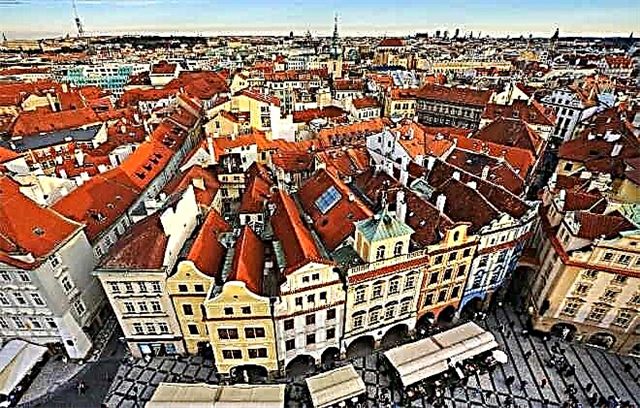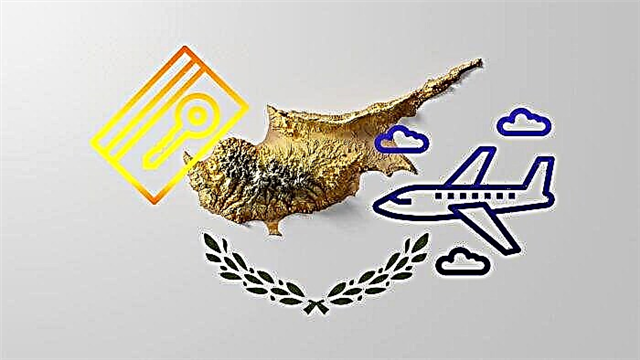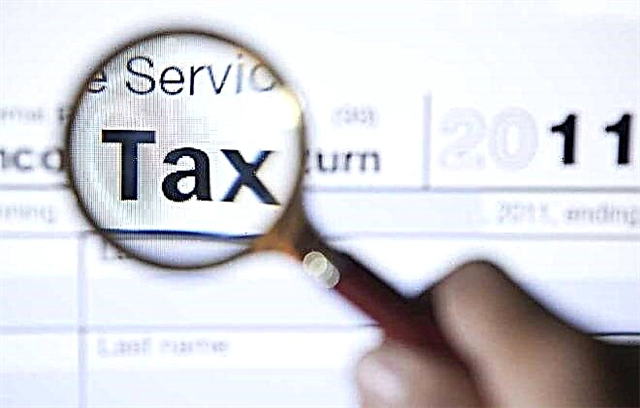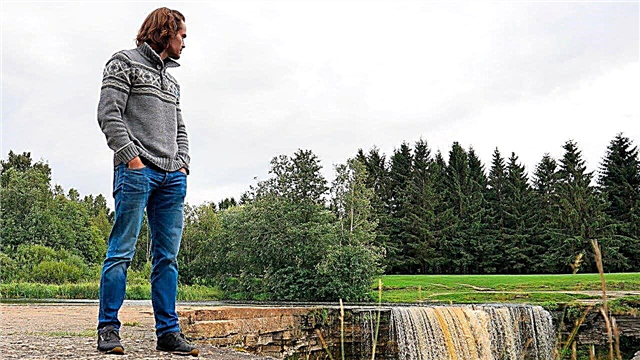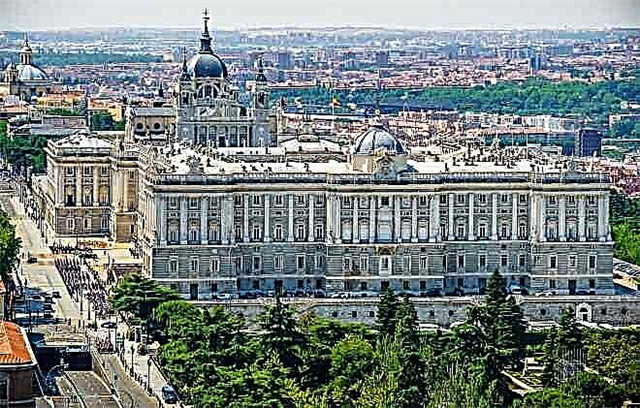Every European country has historical palace complexes that are impressive in their scale and luxury. Tourists are well aware of Versailles and Louvre, Windsor and Buckingham castles, Prague Castle, Roman Quirinal, Vienna's Hofburg. But the grandest monarchical residence in Western Europe is the Royal Palace in Madrid.

Family residence of the Bourbons
The Royal Palace (Palacio Real de Madrid) is located on a hill along the banks of the Manzanares River. In the Middle Ages, the fortress of the Muslim emirs of Toledo stood on this place, and after the transfer of power to the Christians, the Alcazar palace of the Habsburgs was built in its place.
In 1734, the building was destroyed by fire, and in its place King Philip V of Bourbon ordered the construction of a new palace complex in the Baroque style, which could rival the luxury of the French Versailles. Italian architects Filippo Juvarra, Giovanni Battista Sacchetti and Francesco Sabatini were invited for the construction. The project used the ideas of Lorenzo Bernini - the creator of the Parisian Louvre.
The new castle was built from 1738 to 1764, and its interior decoration was improved until the end of the 19th century. The first monarch who settled here was Charles III. The palace served as the residence of the rulers of Spain until 1931.
Today, the royal family occupies the Palacio Real de El Pardo, and the Palacio Real is used as a museum and site for important official ceremonies.
Attractions of the palace complex
Palacio Real is one of the main attractions in Madrid. The size of the building is amazing: the total area is 13 hectares, there are 3418 rooms inside (this is almost twice as much as in Versailles or Buckingham Palace). About 2000 of them are currently renovated, but tourists are only allowed in 50 rooms.
The Royal Palace has a rectangular shape, in the center there is a courtyard with galleries. The building was erected on a hill, therefore, from the side of the river, its foundation rests on special platforms.
The palace was built in the Italian Baroque style with rococo elements and oriental motives. Thanks to this, it got its second name - Palacio de Oriente (Oriental Palace). The main architectural element of the southern facade is Doric pilasters, between which windows and balconies are located. Tuscan columns are installed on the sides of the main entrance. The walls are faced with granite, the relief details are made of marble and white Colmenar stone.
The main entrance of the palace is located on the south side and “looks” at the spacious Arms Square (Plaza de la Armería). On the opposite side, a spacious ceremonial courtyard closes the building of the neo-Gothic Almudena Cathedral.
On the east side of the royal residence adjoins the East Square (Plaza de Oriente). It is an extensive pedestrianized area that includes historical sites and recreation areas with picturesque flower beds.
In the center of the square is the equestrian statue of Philip IV, created in 1640 by the Italian sculptor Pietro Tacca. On the north side there is an alley along which 20 sculptural images of Spanish rulers of different eras are lined up.
Part of the area is occupied by the Lepanto and Cabo Noval gardens, planted with banana trees and cedars. On the east side, the square is closed by the neoclassical building of the Royal Theater, built in 1818-1850.
On the west side of the palace, you will find the Campo del Moro Garden, a popular leisure destination for townspeople and tourists. A statue of Queen Isabella II is installed in a large, picturesque park. In the heat, guests are given coolness by fountains transported from the palace in Aranjuez, the summer residence of the royal family. In the spring, when the hedges and trees are in bloom, the park becomes one of the most colorful and romantic spots in the Spanish capital.
On the territory of Campo del Moro there is a pavilion in which the Museum of Carriages is open. Here you can find ceremonial carriages, landauses, carriages and other horse-drawn carriages, which were once carried by the Spanish kings. Some of the exhibits have survived from the 14th century. In addition, the exhibition features exquisite saddles and ornate horse blankets.
Until the 1930s, the north side of the palace housed stables built by one of the architects of the complex, Francesco Sabatini. Later, the dilapidated buildings were demolished and a landscape park was laid out on the vacant site, which received its name in honor of the legendary architect.
The park landscapes are decorated with sculptures created by the curly shearing of coniferous trees, fountains and flower beds. In summer, the Sabatini Gardens host celebrations and music festivals.
Halls on the ground floor

Unlike many European palaces, the interiors of which were almost completely destroyed during the Second World War and later restored from photographs and drawings, all the historical interior decoration of the Royal Palace in Madrid is original and in excellent condition.
The Royal Library occupies the northwest corner of the palace and is located on two levels. Its interior and bookshelves are made of mahogany.
The library contains a huge collection of historical manuscripts and printed publications, old notes, geographical maps, drawings and graphics - about 300,000 items in total. You can visit the library only for the purpose of scientific research with a special pass.
In the Royal Pharmacy, you will see an unusual exhibition - a collection of bottles, jars, vials and pots for medicines that have been made from the Middle Ages to the present day. In the past, these containers were used to store drugs and medicines, which were used by the Spanish kings.
The Armory is one of the most interesting and spectacular halls of the palace. She stores military armor and weapons of members of the Spanish royal family. Here you can see armor, helmets and swords dating back to the 13th century, tournament armor of Charles V and Philip II, made by famous gunsmiths in Italy and Austria. Some of them bear the personal mark of the legendary Filippo Negroli from Milan, who is recognized as the best master in the manufacture of knightly armor of all times and peoples.
The Royal Kitchen was opened to the public in 2021. Its area is about 2000 square meters. Here you can see ovens, ovens, cooking utensils and utensils that were used to serve palace dishes. It is one of the largest and best preserved historic palace kitchens in Europe.
Premises on the second floor
You can climb to the second floor of the palace by the grand staircase designed by Francesco Sabatini. Steps and railings are made of marble and granite. In the upper part of the hall there are lenses that provide natural light. The Rococo allegorical frescoes that adorn the vault are by Corrado Giaquinto, director of the Spanish Academy of Fine Arts, teacher Velazquez and Goya. There are sculptures of lions on the balustrade.
The Alabarderos Hall, which tourists enter from the main staircase, was designed for balls and dinner parties. Its walls are decorated with pilasters and images of laurel branches, and on the ceiling you can see one of the unique elements of the palace decor - a huge fresco, which in allegorical form depicts the greatness of Spain and the valor of King Charles III. The painting was created in 1764 by the legendary painter Giovanni Battista Tiepolo, an outstanding decorator of the 18th century. The images on the ceiling panels are so light and airy that the illusion of an open sky overhead appears.
The decor of the Column Hall combines smooth pilasters and exquisite carved wood supports, images of lions, satyrs and other mythological creatures. Throughout its history, the hall served as a venue for important official events in the history of Spain, and this tradition continues today.Major diplomatic receptions, international conferences (NATO summit and others), presentation of national sports awards are held here.
In 1985, an association agreement between Spain and the EU was signed in the Hall of Columns, and in 2014, the ceremony of the abdication of King Juan Carlos I and the transfer of royal powers to his son Philip VI took place here.
The throne room is the most luxurious room in the palace. Giovanni Battista Tiepolo and Giovanni Battista Natali took part in its design (the latter developed the design of mirrors, frames, cornices and walls). The Throne Room is considered one of the most spectacular Rococo spaces in the world. Its walls are covered with velvet embroidered with gold and silver threads; all the relief elements are gilded. Life-size figures of gilded lions are located on the pedestal and steps of the throne near the armchairs of the king and queen.
The chapel is one of the most original architectural landmarks of the royal residence. The atrium, columns and volumetric medallions on the dome with lens windows form an unusual spatial composition.
An organ of 1778, made by the best master of the 18th century, Jordi Bosch, is installed in the temple. The tool is still in working order. The armchairs and decoration of the royal box have been preserved since the time of Ferdinand VI. Upholstery in white satin and colored silk with silver embroidery.

Other rooms of the palace are distinguished by no less refined decoration:
- The Gasparini Chamber is decorated in a fancy Chinese style with rococo elements. Its walls are decorated with silk embroidery, marble floors and furniture are designed in the same style. The room contains a musical clock with figures that can move and dance, by the famous Swiss watchmaker Pierre Jacquet Droz.
- The porcelain office is tiled with colored marble panels and painted ceramic tiles.
- The walls of the Hall of Mirrors are covered with delicate stucco ornaments, the frames of the mirrors are decorated with magnificent stucco and gilding.
Tourists can visit the private chambers of the Spanish rulers of different eras: the apartments of Isabella de Farnesi and Maria Luisa de Parma, the office of Charles IV.
Palace art collections
The King's Palace in Madrid houses a large number of art collections, from paintings and sculptures to porcelain and clocks. Due to space constraints, many of these works of art are kept in the museum's storerooms. Now, between the Armory Square and the Almudena Cathedral, the Museum of the Royal Collections is being built, in which they plan to place valuable historical exhibits. The most important historical collections of the palace are the following:
- "Palatine Stradivari" - a set of stringed instruments by the world's most famous master Antonio Stradivari for a classical chamber quartet (two violins, viola and cello). All these instruments are decorated with ornaments, which distinguishes them from other products of the master. In addition, there is one Stradivarius cello in the collection, which is not included in the set. All these instruments were acquired by King Carlos IV in 1775.
- The paintings of the Royal Palace were at one time transferred to the National Museum of the Prado, so there are relatively few artworks left in the castle. But they are all of great value and belong to different eras. On the walls of the halls and in the gallery you can see paintings by Spanish, Italian and Dutch artists: Goya, Velazquez, Jose de Ribera, Caravaggio, Luca Giordano, Rubens, David Teniers the Younger, Luis de Morales and many others.
- The collection of sculptural works is relatively small, but the names of their authors are well known to connoisseurs of art. The palace contains works by the founder of the Baroque style in sculpture Lorenzo Bernini and the master of 19th century realism, Mariano Benlure.
- The furniture in the palace is genuine, it is not a product of later restoration. In the halls you can see elegant tables, chairs, dressers and bureaus in the empire, neoclassicism, baroque and rococo styles.
- The Palacio Real de Madrid watch collection is considered one of the largest and most valuable in the world. There are watches made by the Swiss master Droz, “Golgotha” watches made in Nuremberg, and many other unusual items with unique designs and finishes.
- The collection of antique tapestries of the Royal Palace in Madrid is recognized as the richest in the world after the Quirinal in Rome. There are 16th century canvases from Brussels and products of the Royal Tapestry Factory in Madrid, including drawings based on sketches by Francisco Goya.
- The jewelry exposition presents the family jewels of the Spanish kings, artistic silver and gold dishes. The most interesting examples are the El Estanque diamond weighing 100 carats, which King Philip II bought in Antwerp and presented to his bride Isabella de Valois, and the legendary pearl from Panama Perla Peregrina (La sola).
- The palace also contains symbols of Spanish royalty. The crown was made during the reign of Charles III from gilded silver, the scepter was made during the reign of Charles II. These attributes are used in some official ceremonies, but the rest of the time they are kept in the museum and are available for public viewing.
Reference information for tourists
Address: Plaza de Oriente / Calle Bailen, 6, Palacio Real.
You can get there:
- By metro - lines 2 and 5, Opera station.
- By bus - no. 3, 25, 39 and 148.
- On foot - from the city center from Plaza Mayor along Calle Mayor.
Working hours:
- Royal Palace:
- from October to March daily at 10.00-18.00;
- from April to September daily at 10.00-20.00.
Visitors' access is through the door of the Almudena esplanade, corner of Calle Bailen.
- Campo del Moro Gardens:
- from October to March daily at 10.00-18.00;
- from April to September daily at 10.00-20.00.
- Sabatini Gardens - daily at 8.00-21.00.
Official site: www.patrimonionacional.es/real-sitio/palacio-real-de-madrid.
Tickets to the Royal Palace:
- Full price - €
- Reduced price (children 5-16 years old, students with ISIC card, citizens of the EU or Ibero-American countries over 65 years old) - €
- For organized tourist groups - € 8 / person.
- Children under 5 years old - free.
Additional services:
- Palace guide - €
- Audio guide rental - € There is an audio guide in Russian.
- Temporary exhibitions can be visited at no additional cost, with a regular ticket.
The palace has created conditions for tourists with disabilities.
The museum can be visited for free:
- May 18 (International Museum Day) citizens of any country.
- October 12 (National holiday in Spain) citizens of any country.
- From Monday to Thursday at 16.00-18.00 from October to March and at 18.00-20.00 from April to September citizens of the European Union who have issued a residence permit or work permit in the EU, citizens of Ibero-American countries (by appointment, with an identity card ).
The Campo del Moro and Sabatini gardens are free to enter.
Interesting facts about the Palacio Real de Madrid

Many interesting historical facts are connected with the Royal Palace. We bring to your attention some of them:
- Palacio Real de Madrid is the largest royal palace in Spain, but by no means the only one. There are five other palaces in the country that bear the name Palacio Real: in San Idelfonso, Aranjuez, El Pardo, Riofrio and Almudena.
- In the construction of the Royal Palace in Madrid, wood was practically not used. After a fire that destroyed the previous castle, the king ordered to build a new one from non-combustible materials.
- Philip V, by whose order the Palacio Real de Madrid was built, was the first representative of the Bourbon dynasty on the Spanish throne. For 300 years, the kings of this family lost power three times for a long time, but each time they regained it. The current reigning monarch, Philip VI, is also a Bourbon.
- From 1808 to 1813, the Spanish throne was seized by Joseph Bonaparte, the elder brother of Napoleon Bonaparte. His official residence was at the Palacio Real de Madrid, and he ruled the country under the name José I Bonaparte. But the Spaniards did not recognize his authority and contemptuously called "the first and the last." And so it happened - there were no other Bonapartes on the Spanish throne.
- The last monarch to live in the palace was Alfonso XIII Bourbon. He went into exile following Spain's transition to a republican form of government in 1931.His son Juan Carlos returned to the throne in 1975 after the death of dictator Franco.
- Interestingly, General Francisco Franco, who seized power in Spain in 1939 and ruled the country in the tradition of autocracy, never lived in the Palacio Real de Madrid. He chose to settle in the Royal Palace of El Pardo on the outskirts of the capital.
- The sculptures of the Spanish kings, which now adorn the Plaza de Oriente and the parks near the palace, were originally planned to be installed on the upper cornice of the building. But when they were made, the architect calculated their total weight and decided that it would be better to put them in the park.
- The monument to Philip IV, installed in the Plaza de Oriente, is the world's first equestrian statue in the composition of which the horse rests only on its hind legs. To correctly calculate the center of gravity of the sculpture and prevent it from overturning, the sculptor Pedro Tacca turned to the famous mathematician and astronomer Galileo Galilei.
- The unique 58.5-carat Pearl Pilgrim has an amazing history. It was found in 1515 in Panama and sent by the mayor of the city to King Philip II of Spain. The jewel passed from father to son until 1808, when it was captured by Joseph (Jose) Bonaparte. Later, it was in the possession of Napoleon III, famous European aristocrats and American millionaires, several times crossed the Atlantic, until in 1969 it appeared at an auction in New York. There her bought actor Richard Burton for Elizabeth Taylor. The actress remained the owner of the pearl until her death. It wasn't until 2021 that Pearl Pilgrim returned to the Royal Palace.
- In the Armory, you can see the armor of Charles V, in which the king posed for a portrait to the famous artist Titian. This portrait is now kept in the Prado National Museum.
- There are two flagpoles above the main facade of the palace. On one of them you can see the flag of Spain, the second is empty. When the Bourbon family standard appears on the second flagpole, it means that the king has arrived at the palace for an official ceremony. On such days, access to the palace for tourists is closed.
Palacio Real de Madrid is visited by about 1.5 million tourists annually.
Conclusion
The Royal Palace of Madrid is an outstanding monument of the Renaissance. A museum is currently open at the Palacio Real. Tourists are always interested in the architecture of the building, its interior decoration, unique art collections presented in the halls. When visiting the palace, you should definitely take a walk through the picturesque palace parks.


